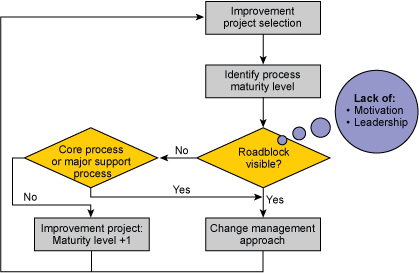
Change agents often are confronted with the need to improve immature processes. These can be processes that are undocumented, uncontrolled or highly variable. For improvement to take place, practitioners must first determine if any roadblocks, such as low employee motivation or a lack of strong leadership, are in place that can keep the process from reaching maturity. If there are no visible roadblocks, practitioners can benefit from using the capability maturity model (CMM) to capture the current process and to take steps toward improving the maturity level of the process. If roadblocks are present, however, practitioners must be prepared for a more in-depth change management approach.
The Capability Maturity Model
The CMM helps practitioners clarify the maturity of a particular process, define an adequate project goal and select the right tools for reaching it. This model was primarily developed for software engineering, but it also is applicable to other business processes. The model is especially useful for the early phases of a business excellence deployment, when immature processes are the rule, not the exception.
The CMM distinguishes five process maturity levels. Practitioners can use the improvement approaches shown in the table below to increase the maturity level of a process.
| Table 1: Process Improvement Approach for Each Maturity Level | ||
| Maturity Level | Process Status | Process Improvement Approach |
| Ad hoc | The process is undocumented and/or in a state of dynamic change. It is driven in an ad hoc, uncontrolled and reactive manner by users or events. | Make the process repeatable:
|
| Repeatable | The process is repeatable, possibly with consistent results. However, there is inherent variation among people doing tasks in the process. A process owner may be defined, but process discipline is unlikely to be rigorous. Where it exists, it may help ensure that the process is maintained in times of stress. | Define and measure the process:
|
| Defined and measured | The process is clearly defined, process discipline is given and key performance indicators are monitored. The process is documented and subject to some degree of improvement over time. | Manage the process:
|
| Managed | Management uses process metrics and control methods to identify ways to continually adjust the process to customer requirements. Process capability is monitored. | Make the process self-optimizing:
|
| Self-optimizing | Processes at this level focus on continually improving process performance through both incremental and innovative changes and improvements. | Spread the self-optimizing approach:
|
Recognizing Problems
Process teams may reach the managed level of process maturity by intuition or by being guided through a literature review or basic training. Individual teams and initiatives composed of several improvement projects can then use CMM to quickly and effectively identify the maturity level of a process, select a suited improvement approach and define the steps to complete it.
Process improvement, however, also can stall at fairly low levels of maturity. This sometimes happens in spite of a professionally conducted improvement initiative. Lack of success in these initiatives often is due to a lack of motivation or of leaders who are trained in the process. Frequent changes in management, corporate politics or inaccessible process knowledge may be at the root of the problem. Overcoming these issues requires more than simply a skillful application of improvement tools from the CMM table above.
Improving Low-maturity Processes
In a variation on the beginning of Tolstoy’s Anna Karenina, an experienced practitioner might say: “All highly mature processes resemble one another. All immature processes are immature in a very specific manner.”
In the best of situations, improvement teams encounter low maturity processes within an organization that has motivated stakeholders and clear lines of leadership. In these cases, it should always be possible to improve the situation following this approach:
- Quickly increase the process maturity by one level.
- Leave the process alone for some time.
- Eventually, submit further process improvements to a project selection process.
For early phases of a deployment, the improvements completed in order to reach the next maturity level can contribute to the creation of a pool of success stories. Kaizen events can help implement changes quickly.
Improvement teams are faced with a completely different challenge when they find a major support process with low maturity. The correlation between process, motivation and leadership maturity makes it likely that shortcomings in the latter two are present whenever a process of such importance is found at low maturity. To make improvements, practitioners should follow a change management approach rather than a continuous improvement approach (Figure 1).

In most cases, processes without clear motivation and leadership will require serious management attention and an improvement team leader with solid change management experience. One way to start these major changes is with a cathartic culture intervention prior to the introduction of improvement tools and methods. This can help build a sense of urgency, a motivation to re-examine mental models, and a willingness to “blow things up” and reengineer a process.